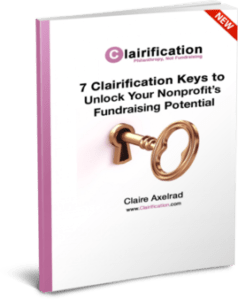 Fundraising is too often seen, at best, as a ‘necessary evil.’
Fundraising is too often seen, at best, as a ‘necessary evil.’
When viewed this way, folks – staff and volunteers alike – understandably prefer not to touch it with a 10-foot pole. Who wants to place themselves on the side of ‘evil?’
Yipes stripes!
But that’s not what fundraising is at all.
The tagline for my business, Clairification, is “philanthropy, not fundraising.” I often talk to folks about how the word philanthropy comes from the Greek and translates into “love of humankind.” Nothing evil about that!
In fact, if you ask folks to throw out the first word that comes to mind when you say ‘fundraising,’ and then ask them to do the same when you say ‘philanthropy,’ you’ll see it breaks down pretty neatly between good and evil.
Why it’s Important to Reframe Fundraising
If you’re coming at fundraising from the perspective of ‘necessary evil’ or ‘no pain, no gain,’ you’re never going to be effective. Especially when it comes to asking individuals, one-to-one, for passionate gifts.
As long as you hate it, donors will be able to tell you hate it. I call this wallowing in the pain. Never a good approach. Distaste for asking begets distaste for giving. It’s done grudgingly, not passionately.
When donors can sense you’d rather be doing anything else than asking them for a gift, guess what happens? They follow your lead! In other words, they feel they’d rather be doing anything else than making a gift.
But there’s more to reframing fundraising so it’s seen as a really, truly good thing.
I like to reframe it thusly:
- It’s a responsibility.
- It’s a privilege.
- It’s an opportunity.
Fundraising is a Responsibility
If you’re fortunate enough to be a successful nonprofit, this means you’re helping solve some of the world’s most pressing problems. You’re making a demonstrable impact, and folks are relying on you to keep doing so. To hold to your commitments.
It’s your responsibility not to abandon those who rely on you.
This means it’s also your responsibility to assure there is funding for you to continue your work.
This is why instilling an organization-wide culture of philanthropy is so important. Because too often nonprofit leaders think their only responsibility is to do the work, rather than also fund the work. Let someone else worry about that.
No. There is no someone else. It’s all your responsibility. The two obligations – doing and funding — go hand-in-hand. They’re inseparable.
As long as anyone in the organization doesn’t understand your common responsibility to further your mission includes fundraising, you’re simply not going to be all that you can be.
Fundraising is a Privilege
Once you’ve established yourself as a successful nonprofit, and you’re making a real difference, fundraising merely projects your values into the community; it cannot function apart from your organization and the demonstrated needs you are meeting.
You earn the privilege to reach out into the community for funding to further your efforts when you’ve demonstrated effectiveness.
It becomes part of everyone’s job to tell the story of your impact and share how much greater that impact can become with your donor’s help. You aren’t asking for yourself, but on behalf of others. Don’t demean the ask by clothing it with an apology.
You aren’t asking because you’re needy, but because of the needs you meet. You and your donor become partners in meeting needs and creating positive outcomes. It’s your job to help people understand their money can make that happen. Retire the tin cup. You aren’t begging.
Fundraising is an Opportunity
As long as you think fundraising is taking something away from donors, you’re sunk. That’s the absolute worst way to approach philanthropy. Kevin Barenblat writes in Harvard Business Review that the most successful nonprofits think of fundraising differently: They’re as thoughtful about the benefits to the funder as about those to the beneficiaries they serve.
Offering an opportunity to make a difference in a manner that reflects shared values is a gift.
You absolutely must understand that giving brings people joy. MRI studies have shown when people merely contemplate making a gift the pleasure centers of their brain light up! Giving gives folks a warm glow that feels as good as sex or chocolate.
Why wouldn’t you, the fundraiser, want to facilitate this warm glow?
If you know someone likes Thai food, and you happen on a great Thai restaurant, wouldn’t you share this with them? Of course! Because you know it would be a gift. It would be useful to them because part of their purpose in life is to find great Thai food. What holds true for sharing restaurant recommendations holds true for sharing charitable giving recommendations.
It’s all about matching the values your organization enacts with the values your donor holds.
Fundraising Offers a Values Pay-off
Once you’ve reframed fundraising as described above, approaching a donor to ask for a philanthropic gift becomes an exercise in matching value for value.
You ask the donor to give you something (money, goods, services or time) and, in turn, you offer an intangible reward that helps them find purpose and meaning.
Another way to think of this is that, through fundraising, you hold up a mirror.
When the donor looks into this mirror, they see the person they want to be. They see a mensch or champion coming to the rescue… saving the day… giving the story you’ve told them a happy ending.
SUMMARY:
If you approach asking as an onerous, to-be-avoided chore, your urge to get it all over and done with as quickly as possible will get in both your and your donor’s way.
Sure, you’ll get some token or one-time gifts this way, but these folks are not likely going to feel good about their giving. They’re not likely to become passionate about your cause, or to remain lifelong, loyal and dedicated supporters.
You don’t engage in fundraising because you’re passionate about twisting people’s arms or “hitting people up” (at least I hope not). You engage in fundraising (you facilitate philanthropy) to create more love. You invite people to join you in making the world a more caring, loving, harmonious, just and beautiful place.
Remember: fundraising is never an end in itself; it draws meaning from ends served.
Fundraising is practice; how you meet the goal. The goal is to continue the mission – something decidedly good, that good people care about. As my teacher, someone who’s been called the “Daddy of Fundraising,” Hank Rosso, said: Fundraising is the gentle art of teaching the joy of giving.
“Fund-raising is proclaiming what we believe in such a way that we offer other people an opportunity to participate with us in our vision and mission.”
– Henri Nouwen, The Spirituality of Fundraising
Want to Learn More about Reframing Your Approach to Your Work?

Get fresh insights into how fundraising and marketing have changed, and what this means for you.
Get the 7 Clairification Keys to Unlock Your Nonprofit’s Fundraising Potential.Through a series of clairifying worksheets and individual and group exercises, this 42-page guide will give you fresh insights into how fundraising and marketing have changed – and what that means for you and your organization. You’ll learn how to:
- Clairify your Values and lead from passion, not need.
- Clairify your Stories and share them; make your donors lead characters.
- Clairify your Brand and listen for offers; seize opportunities.
- Clairify your Social Channels and meet folks where they are.
- Clairify your Support Constituencies and be accountable.
- Clarify your Engagement Objectives and measure.
- Clairify your Resources/Systems for creating positive customer experiences.
This is your opportunity to refresh your thinking, and refresh your plans. If you’re not satisfied, for any reason, you have my 30-day 100% refund guarantee. Plus I offer a complementary 15-minute consultation!
Photo by pine watt on Unsplash.






Hi Claire,
This is one of the best writings about our work. Thank you for the inspiration. And the framing. People give to change the lives of others. We help make that happen.